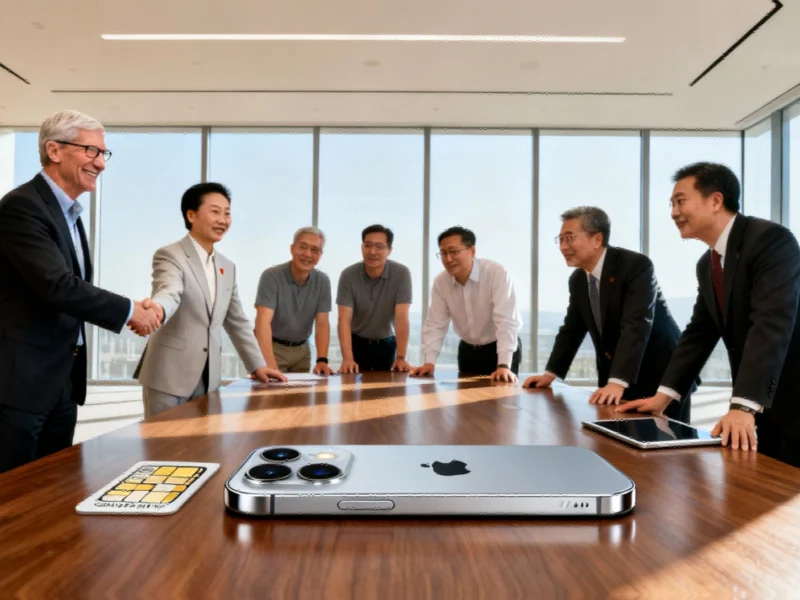Navigating Geopolitical Crossroads
Apple CEO Tim Cook’s recent high-profile visit to China has yielded significant diplomatic achievements, with the Chinese government formally endorsing Apple’s continued operations in the country. This development comes at a crucial juncture as Apple attempts to balance competing pressures from Washington and Beijing. The official backing from Chinese authorities provides Apple with much-needed stability in one of its most critical markets.
During meetings with Chinese Minister of Industry and Information Technology Li Lecheng, Cook secured resolution of regulatory obstacles that had stalled the launch of the eSIM-only iPhone 17 Air in China. This breakthrough demonstrates Apple’s continued ability to navigate China’s complex regulatory landscape despite escalating US-China trade tensions.
Strategic Investments and Supply Chain Realignment
Apple’s commitment to China extends beyond regulatory compliance. The company has made substantial investment pledges to both the United States and China, reflecting its delicate balancing act. While committing $600 billion to develop domestic US semiconductor capabilities, Apple continues to deepen its manufacturing footprint in China, where it benefits from unparalleled economies of scale and sophisticated supply chains.
The significance of Apple’s Chinese operations was underscored by COO Sabih Khan’s visit to Lens Precision facilities in Taizhou. As a subsidiary of Lens Technology, this supplier plays a crucial role in producing components for multiple Apple products, including the technologically advanced iPhone 18 camera system that’s already causing ripple effects across the global supply chain.
Manufacturing Diversification Challenges
Apple’s efforts to reduce its China dependency face substantial hurdles. Despite shifting some iPhone production to India, analysts at Jefferies project that Apple will still ship approximately 9 million iPhones from China to the US in fiscal year 2026. This persistent reliance underscores the challenges of replicating China’s manufacturing ecosystem elsewhere.
The company’s diversification strategy extends to Vietnam, where it plans to manufacture upcoming home devices including a 7-inch HomePod, security cameras, and tabletop AI robots. This move leverages BYD’s manufacturing facilities in the country and represents Apple’s attempt to create more resilient supply chains amid geopolitical uncertainties.
Technological Context and Market Dynamics
Apple’s strategic positioning occurs against a backdrop of rapid technological advancement across multiple sectors. The growing sophistication of AI-powered security threats highlights the importance of robust digital ecosystems, while competitors like Amazon pursue next-generation energy solutions to power their operations.
In the computing space, companies including ASUS are innovating with new form factors, while the broader industry witnesses intense competition in AI-driven commerce platforms that could eventually challenge Apple’s service revenue streams.
Political Vulnerability and Strategic Positioning
Despite Apple’s careful planning, the company remains vulnerable to sudden policy shifts from the US administration. The recent increase in Apple’s US investment commitment from $500 billion to $600 billion followed President Trump’s imposition of punitive tariffs on India, demonstrating how quickly geopolitical developments can alter corporate strategy.
“The fundamental challenge for Cook,” observes a veteran industry analyst, “is maintaining operational flexibility while political winds shift unpredictably. Apple’s cash reserves provide some insulation, but no company is entirely immune to trade war escalations.”
Cultural Connection and Market Commitment
Cook’s personal affinity for China has become a strategic asset. During his visit, he emphasized his connection to the country, stating: “I always want to come back. There’s always so much change. It’s so dynamic. I love the Chinese people and culture and it’s wonderful to be in Shanghai.” This cultural diplomacy complements Apple’s business objectives in maintaining access to China’s vast consumer market and manufacturing capabilities.
As Apple continues its tightrope walk between American political pressures and Chinese economic realities, the company’s substantial financial commitments to both nations represent its primary strategy for navigating the ongoing US-China decoupling. The recent Chinese government endorsement provides crucial stability, but the long-term sustainability of Apple’s balancing act remains uncertain in an increasingly polarized global economy.
Based on reporting by {‘uri’: ‘wccftech.com’, ‘dataType’: ‘news’, ‘title’: ‘Wccftech’, ‘description’: ‘We bring you the latest from hardware, mobile technology and gaming industries in news, reviews, guides and more.’, ‘location’: {‘type’: ‘country’, ‘geoNamesId’: ‘6252001’, ‘label’: {‘eng’: ‘United States’}, ‘population’: 310232863, ‘lat’: 39.76, ‘long’: -98.5, ‘area’: 9629091, ‘continent’: ‘Noth America’}, ‘locationValidated’: False, ‘ranking’: {‘importanceRank’: 211894, ‘alexaGlobalRank’: 5765, ‘alexaCountryRank’: 3681}}. This article aggregates information from publicly available sources. All trademarks and copyrights belong to their respective owners.



